
The Tabularium was the official records office of ancient Rome and housed the offices of many city officials. Situated within the Roman Forum, it was on the front slope of the Capitoline Hill, below the Temple of Jupiter Optimus Maximus, to the southeast of the Arx.

The Imperial Fora are a series of monumental fora, constructed in Rome over a period of one and a half centuries, between 46 BC and 113 AD. The fora were the center of the Roman Republic and of the Roman Empire.

The Suburra, or Subura, was a vast and populous neighborhood of Ancient Rome, located below the Murus Terreus on the Carinae and stretching on the slopes of the Quirinal and Viminal hills up to the offshoots of the Esquiline.
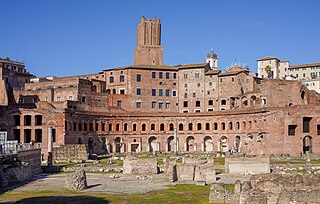
Trajan's Market is a large complex of ruins in the city of Rome, Italy, located on the Via dei Fori Imperiali, at the opposite end to the Colosseum. The surviving buildings and structures, built as an integral part of Trajan's Forum and nestled against the excavated flank of the Quirinal Hill, present a living model of life in the Roman capital and a glimpse at the restoration in the city, which reveals new treasures and insights about ancient Roman architecture.
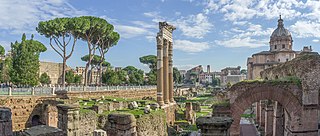
The Forum of Caesar, also known by the Latin Forum Iulium or Forum Julium, Forum Caesaris, was a forum built by Julius Caesar near the Forum Romanum in Rome in 46 BC.

The Temple of Antoninus and Faustina is an ancient Roman temple in Rome, which was later converted into a Roman Catholic church, the Chiesa di San Lorenzo in Miranda or simply "San Lorenzo in Miranda". It is located in the Forum Romanum, on the Via Sacra, opposite the Regia.

The Temple of Vespasian and Titus is located in Rome at the western end of the Roman Forum between the Temple of Concordia and the Temple of Saturn. It is dedicated to the deified Vespasian and his son, the deified Titus. It was begun by Titus in 79 after Vespasian's death and Titus's succession. Titus’ brother, Domitian, completed and dedicated the temple to Titus and Vespasian in approximately 87.
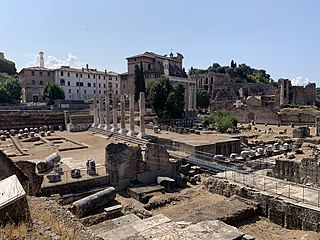
The Temple of Peace, also known as the Forum of Vespasian, was built in Rome in 71 AD under Emperor Vespasian in honour to Pax, the Roman goddess of peace. It faces the Velian Hill, toward the famous Colosseum, and was on the southeast side of the Argiletum.

The main road to the Roman Capitol, the Clivus Capitolinus starts at the head of the Roman Forum beside the Arch of Tiberius as a continuation of the Via Sacra; proceeding around the Temple of Saturn and turning to the south in front of the Portico Dii Consentes, it then climbs up the slope of the Capitoline Hill to the Temple of Jupiter Optimus Maximus at its summit. This was traditionally the last and culminating portion of all Roman triumphs.

Forum of Nerva is an ancient structure in Rome, Italy, chronologically the next to the last of the Imperial fora built.
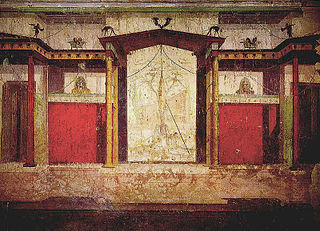
The House of Augustus, or the Domus Augusti, is situated on the Palatine Hill in Rome, Italy. This house has been identified as the primary place of residence for the emperor Augustus.
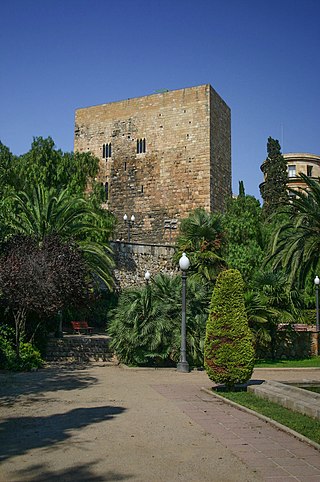
The provincial forum of Tarraco is a Roman archaeological site in Tarragona, Catalonia, Spain, encompassing an area of 18 ha. Together with other Roman remains in the city it makes the Archaeological Ensemble of Tarraco, which was listed in the UNESCO World Heritage Sites in 2000.

The basilica of Santi Cosma e Damiano is a titular church in Rome, Italy. The lower portion of the building is accessible through the Roman Forum and incorporates original Roman buildings, but the entrance to the upper level is outside the Forum.

The Insula dell'Ara Coeli is one of the few surviving examples of an insula, the kind of apartment blocks where many Roman city dwellers resided. It was built during the 2nd century AD, and rediscovered, under an old church, when Benito Mussolini initiated a plan for massive urban renewal of Rome's historic Capitoline Hill neighbourhood.

The Regio IV Templum Pacis is the fourth regio of imperial Rome, under Augustus's administrative reform. Regio IV took its name from the Temple of Peace built in the region by the emperor Vespasian. It includes the valley between the Esquiline and the Viminal hills, the popular area of the Suburra, and the Velian Hill.

The Regio VIII Forum Romanum Magnum is the eighth regio of imperial Rome, under Augustus's administrative reform. Regio VIII took its name from the Roman Forum, the political centre of Ancient Rome.

The Sanctuary of Hercules Victor in Tivoli (Italy) was one of the major complexes of the Roman Republican era built on the wave of the Hellenistic cultural influence after the final Roman conquest of Greece. It was built just outside the ancient city of Tibur and is the largest of Italic sanctuaries dedicated to Hercules, and the second in the whole Mediterranean after that of Cádiz in Spain. It was built between about 120 and 82 BC and was a masterpiece of Roman engineering with many innovations. Further building was done in the Augustan period especially in the theatre area. Augustus administered justice here on numerous occasions, under the arcades of the sanctuary.






















